There is a smorgasbord of styles at the Center for Emerging Visual Artists right now. The show, entitled Beyond Abstraction, was assembled by visiting curator Katrin Elia and consists of eight artists with mediums as wide-ranging as video and encaustic to fabric and wood. With such disparity even within the realm of abstractions, it is necessary to focus on a few aspects of the show.
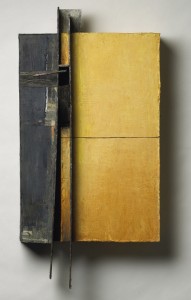
Of immediate interest to me upon entering the space was artist Brian Dickerson. His pieces are subtle, yet powerful. Reminiscent of hard-edged architecture and I-beams, these objects are in fact inspired by the mountainous New York retreat where Dickerson often works. They remind us of the stoic character shared by nature and, often times, human constructions as well.
Slanted shards of wood form little crevices and tiny structures that rise from the mostly flat backgrounds of his works. The colors are dull and earthy, but in a way that compliments his materials very well. While I most often prefer vibrant colors, Dickerson chooses pigments that are true to the naturalistic undertones of his work as well as the more reserved sentiments of the show as a whole.
Also of significance is the large-scale work by Antonio Puri. A target is centrally located on the wall-sized canvas and is smeared with mottled patterns that resemble a sort of degradation from centuries that have never actually aged its surface. This play on time also nods to the image’s dichotomous nature of bull’s-eye-as-mandala.
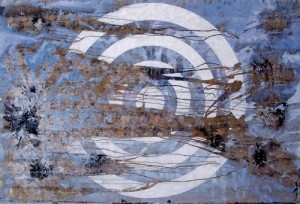
The heavily worked canvas is certainly a reference to Puri’s native India and Buddhist roots. One can sense the meditative diligence with which he rendered this piece. The seemingly ageless distinction of East versus West is blurred as much as time itself.
Alan Soffer’s encaustic pieces, while much smaller than Puri’s work, are still heavy-hitters. Warped wax and viscous hues ooze in various directions across the surface of his works, effectively thumbing their nose at physics.
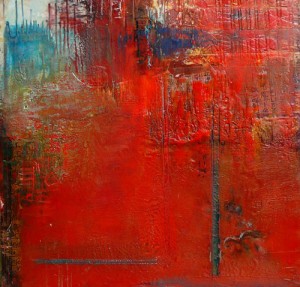
These pieces appear heavy as they sag from the walls both in terms of the thick waxy surfaces and their content. One square surface, entitled “Militarized/Demilitarized,” is streaked with deep, blood-red hues and barely visible Korean characters, which peer through the chaos. At a time when North Korea threatens not only its neighbor to the south but much of the world, this emotionally charged criticism is silent and violent much like the rogue state.
Gillian Pears’ photos serve to balance out the harsh tone of works like Alan Soffer’s. These images are soft and monochromatic studies of different fabric-like materials draped or placed in various compositions. They highlight everyday vulnerability through the medium of seemingly mundane objects and have fairly apparent feminine overtones. Their minimal nature pairs them nicely with Brian Dickerson’s constructions, but their gentle appearance and openness is a welcomed palette-cleanser in this show.
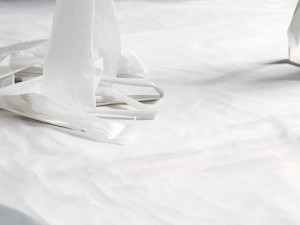
Another abstract art show at Tiger Strikes Asteroid makes a good point of comparison. Two artists, Brandon Anschultz and John Tallman, share the small space with works that play up the process of making an abstract art work. The artists have similar naturalistic processes that they use to create fairly minimal pieces.
John Tallman uses dyed urethane resin to coat the surfaces of fiberboard into planes of reflective hues. The curious element of these shaped pieces of pure color is that, while one peers into their seeming simplicity, the inconsistencies of the resin and the reflections become apparent. Reflection here is not just a literal play on light, but in a way, a form of introspection as the depth of these pieces emerges.
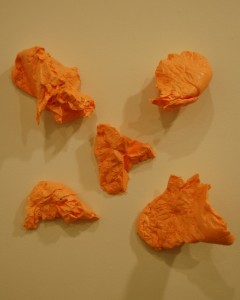
Using plastic bags and armatures, Tallman also fills makeshift molds with resin as well, sometimes creating geologic-looking forms of unnaturally colored sediment. Of particular interest are the orange-tan, almost flesh-colored hunks of resin he has hanging in pieces from one section of wall. They seem like some sort of cloning experiment gone wrong, and cause a notable amount of anxiety in the viewer; the uneasiness is what makes them stand out.
Oil paint applied to porous surfaces is Brandon Anschultz’s primary medium in this show. The pigments stick together and dry in their natural states, while the oils themselves are absorbed into the material they are painted on. This forms colorless stains around the primary forms, and makes them look almost like parts of the floor of a studio instead of something hanging on a wall.
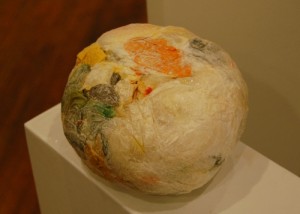
Two of Anschultz’s creations are 3-dimensional balls of material including paint and sawdust, rubber gloves and resin. The latter is literally composed of old gloves Anschultz used in making other art. He balled them up with whitish resin and let it all congeal in a bag – certainly a better use of discarded gloves than tossing them in a trash bin.









